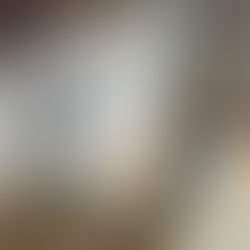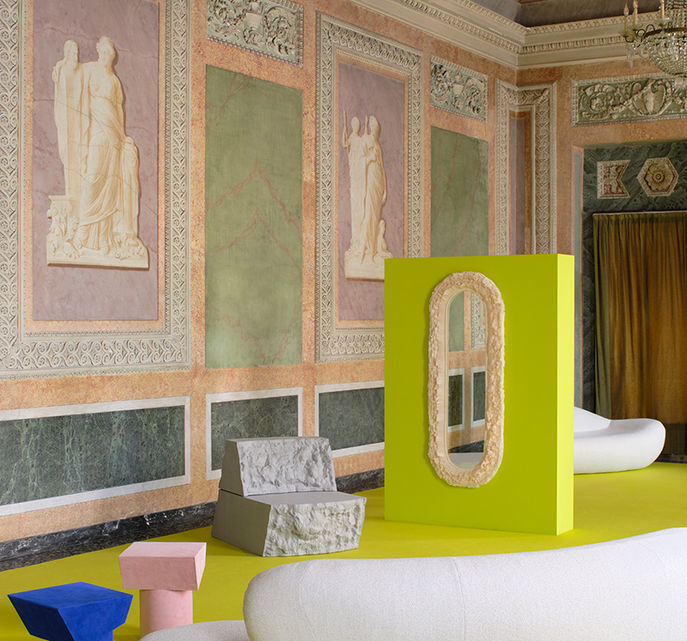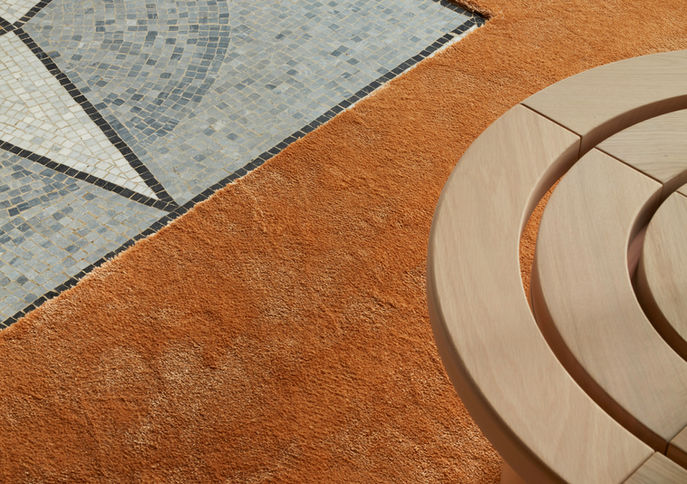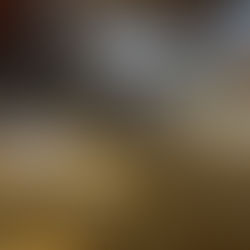OFFSCREEN 2025: The Sacred Revisited at the Salpêtrière
For its 4th edition, from October 21 to 26, 2025, OFFSCREEN leaves private palaces to occupy the Chapelle Saint-Louis de la Salpêtrière, a jewel of religious architecture that has long remained confidential.
Designed by Louis Le Vau, architect to King Louis XIV, and completed by Libéral Bruant, to whom we owe the Hôtel des Invalides and Notre-Dame des Victoires, the chapel has a Greek cross plan where four naves and four chapels meet beneath an octagonal dome pierced by windows and an oculus—a small circular opening set in a wall or at the top of a cupola. A solemn yet luminous arrangement, designed to guide the gaze toward the sky, or here, toward art.
Where the mystery of the sacred once played out, OFFSCREEN establishes its own contemporary ritual. Following the Hôtel Salomon de Rothschild and the Grand Garage Haussmann, the festival transforms this architectural monument of contemplation into a space for visual experimentation: 28 artists, 27 galleries, a constant dialogue between still image, movement, and space. The exhibition design, by LA.M Studio, plays with perspectives and light to reveal the silent monumentality of the space.
The guest of honor, Shigeko Kubota (1937–2015), a pioneer of video sculpture, bridges the gap between art and technology. Her legacy and those of the other exhibiting artists will be explored during a series of discussions bringing together curators from MoMA, the DIA, and the ZKM.
The highlight of this edition: In This Mortal House Building 3 by Maria Stamenković Herranz, a six-day performance that will take place in the chapel's historic choir. Blindfolded, the artist will erect a spiral of 1,440 raw bricks, before destroying it in a cathartic gesture, like a liturgy of matter, at the end of the festival.
Anchored within the Pitié-Salpêtrière Hospital, once a hospice for "deviant" women and then the cradle of modern psychiatry with Pinel, Esquirol, and Charcot, the chapel carries within it a whole history of the body, control, and liberation. Beneath its dome, OFFSCREEN reactivates this tension between faith and fragility, between architecture and flesh.
A place of care, now a place of vision.
More information at offscreen.com


Architecton, or the sublimation of stone.
This is the story of the stone, masterfully told by meticulous Russian director Victor Kossakovsky.
First, the story of its beauty. Contemplative. Every shot is sublime, perfectly framed, with just enough to remind us of the presence of living things, a little ant passing by, a dog strolling along the black-and-white stairs. A contemplation that leaves room for identification. The stones resemble us, they dance and literally express themselves through explosions or constructions that come to life to the effective sound of composer Evgeny Galperine's poetic music.
But it's also the story of our civilization, through construction. A construction that raises the director's own question: how are we to inhabit the world of tomorrow? Because architecture isn't just about designing a building to protect us, it's also about politics, about the meaning we want to give to our civilization and its future.
Through stone, the documentary puts its finger on the paradox between concrete, mass-produced and used today as the flagship material for many buildings, and its ancestor, stone, which remains intact in remains dating back thousands of years. Concrete, on the other hand, cracks and crumbles, is expensive and not all that durable. In fact, it's said to last only about forty years!
This architectural journey therefore raises the question of recycling, of the destruction / construction of our lifestyles and consumption patterns, and brings us back to the very essence of our own values and the dream of building with the heart in a spirit of quasi-spiritual durability, rather than building fast but badly.
“I appeal to scientists and engineers: we need to mobilize 8 billion brains to find a substitute for concrete.We have to find something that allows us to build things that last, with respect for nature”, says the director of this visual masterpiece, which takes concrete as its starting point, but transports us into a perfection of the meaning of life and nature, in search of sustainable architecture.
E.1027, Eileen Gray and the house by the sea.
E.1027 is the story of a house built out of sight in 1929 by one of the world's first and most influential women architects and designers, Eileen Gray. E for Eileen, 10 for Jean's J (the 10th letter of the alphabet), 2 for Badovici and 7 for Gray.
The fruit of a close collaboration with Jean Badovici, her companion at the time, distinguished architect and founder of the avant-garde magazine “L'architecture vivante” (published between 1923 and 1933), this house, accessible only via the coastal path at Roquebrune-Cap-Martin, is a discreet masterpiece of the modernist era of the 1930s, where a soul of millimetric sensitivity reigns.
For this is the Irish designer's strength. Emotion. For her, interior design and architecture are not simply formulas, but must reflect the soul of the person or people living there. All E.1027 furniture, for example, is made to measure in this spirit, and today is among the most exclusive and expensive in the world. And yet, these designs are popular. Copied and re-edited, these chromed steel tubular structures and stacked roller armchairs inspired by the comfortable Michelin man, are now anchored in the collective unconscious and among the most iconic design pieces of the 20th century.
Sensitive, free and non-conformist, Eileen Gray defined herself neither as a designer nor as a decorator. “Lacquered screens, lacquered furniture, wooden furniture, stained materials, lamps, divans, mirrors, carpets, apartment decorations and installations” was her calling card. Discreet like E.1027, she shunned the glitz and glamour of the system. Unlike Badovici, who invited Le Corbusier to discover the house. Later, “Corbu” covered the walls with murals and published photographs. Gray described the frescoes as vandalism and demanded that they be removed. Ignoring his wishes, Le Corbusier built his famous Cabanon just behind E.1027. So much so that this hybrid documentary traces their history through the prism of this interpretation of the power of female expression and men's desire to control it.
A plot to which Director Béatrice Minger (and co-director Christophe Schaub) adds: “At the heart of this film is an unresolved conflict. You could say that Le Corbusier did nothing wrong.Eileen Gray wasn't there when he arrived. Jean Badovici gave him permission to paint the murals and even encouraged him. But is it acceptable to violate and appropriate another artist's artistic vision? Of course not, I'd say. I felt an unease around this conflict, an indignation, that I couldn't rationalize. I saw it as a starting point for a film.”
Art Basel Paris offers free events open to all during art week.
From October 16 to 20, Art Basel takes place in Paris, one of the world's leading contemporary art fairs in the world.
In all, some 195 galleries from 42 countries will be exhibiting art all over Paris, notably at the now renowned GrandPalaisRmn (Grand Palais - Réunion des Musées Nationaux), just renovated after three years of necessary restoration work, but also at the heart of a dozen of Paris's cultural and historical institutions, with, for the first time, a public program entirely free and open to all.
This public program, whose official partner is none other than the iconic Italian fashion brand Miu Miu, will take place throughout the capital, featuring exhibitions, installations and monumental sculptures by renowned artists such as the immersive German agronomist Carsten Höller and his three-meter-high “Giant triple mushroom” at place Vendôme (October 15-November 24), or the organic sculptures cast in pine tar and urine “A real boy” by French artist Jean-Charles de Quillacq in the 17th-century chapel of the Petits-Augustins des Beaux-arts de Paris (October 14-20).
For the occasion, Miu Miu (re)invests its usual Palais d'Iéna (headquarters of the French Economic, Social and Environmental Council, where it presents its collections every year) with the committed “Tales & Tellers” project, a societal exploration through film screenings, installations and conversations with women artists and directors such as Agnès Varda, Zoe Cassavetes and Chloë Sevigny, all of whom have collaborated and inspired the brand over the years in the Women's Tales series of short films.
As for the Grand Palais, admission is charged (from 44 euros), and the fair offers a selection of galleries 27% larger than last year's at the Grand Palais Ephémère, with three paths of exploration: Galeries (established artists), Emergence (the cutting edge of emerging artists) and Premise (exclusive and singular works, which may include pre-1900 creations).
As poetically described by Swiss artist Gina Folly (Emergence sector, represented by Fanta-MLN) and her three varnished cardboard boxes adorned with four stabilized orange zinnias, “Dreams are the raw materials of reality”!
More information and reservations for events, conversations and visits on Art Basel Paris.
"Jeans" de Jean-Charles de Quillacq © Aurélien Molle
"Giant triple mushroom" de Carsten Höller Place Vendôme © Pierre Björk / Gagosian
Les Grands Parisiens: the cultural and tourist guide celebrating Le Grand Paris and the Paris 2024 Olympic Games!
Paris will always be Paris. But there's more to Paris than just the 75th arrondissement. From now on, you'll have to reckon with Le Grand Paris region and its 12 million inhabitants, climb over the périph' to the top of its 12,000 km2 playground, and set off to discover its map with its many treasures of local suburbs*.
1,200 performance venues, over 300 museums and arts centers, 200 festivals, five World Heritage sites, four breathtaking regional nature parks, as well as sports fields as prestigious as they are little-known.
So, doesn't this deserve a guidebook? That's what cultural venue Les Magasins Généraux and journalists from Enlarge your Paris have launched in 2018.
For its third edition, this year's guide offers a selection of over 300 addresses (museums, restaurants, galleries, wastelands, parks, urban farms, vegetable gardens, caves, skateparks...), including around 50 dedicated to sport, to celebrate the Paris 2024 Olympic Games in fitting style. It's also a way to open an unusual window on sport and its history, with an introduction to jeu de paume - the ancestor of tennis, which has disappeared from France, and the world's first racket sport - at the Château de Fontainebleau!
Innovative, more creative, greener, more dynamic - that's how we want to tell the story of Greater Paris, through images captured with humor by photographer Vincent Migrenne, a map divided into ten major new districts, from the Green Ocean to the Enchanted Forest, and a map of the future public transport network, the Grand Paris express, which will leave no excuse to take the plunge, when you discover that with line 15, Bagneux and Villejuif, although geographically close but separated by the freeway, will be only 3 minutes away, compared with 25 minutes at present!
* The word "Banlieue" dates back to the 13th century, and refers to the "outcast" areas outside the city walls.
Le guide des Grands Parisiens, available in bookshops, 20 euros.
© Vincent Migrenne
The Taglio armchair enters the Mobilier national.
Designed as a furniture sculpture, available in wood and fabric, Taglio by architect and designer Rodolphe Parente is one of the 54 pieces entering the prestigious Mobilier national collections in 2024.
A major place for the conservation and transmission of exceptional know-how of French heritage, the Mobilier national has been carrying out acquisition campaigns since 2020 intended to enrich its collections and support contemporary creation and artistic crafts.
Reflecting the evolution of official furnishings in France since the 17th century, the institution has nearly 130,000 items (tapestries, furniture, ceramics, chandeliers, lace, embroidery, etc.) intended to adorn the high places of the Republic, such as Elysée Palace.
The Mobilier national workshops and factories are open to the public, from Gobelins in Paris to Savonnerie in Lodève.
More information on Mobilier national.
The 2025 acquisition campaign runs until May 15, 2024.
© Studio Erick Saillet
From red to black, Frédéric Imbert gives the Reflet Médicis a makeover.
"The surprised eye wanders, aroused, flattered, before the projection begins, and the spectator lets himself be carried away. A movie theater is a place that welcomes the world and offers it the opportunity, for the duration of a film, to marvel, discover, love, cry, laugh, think... It must be a protective place, where the mind can finally allow itself to dream."
These are the words of designer Frédéric Imbert on his latest project at Reflet Médicis, one of the five independent Art et Essai cinemas run by the Parisian institution Dulac.
Black and anthracite replace the traditional red* of the velvety partitions, the raw material of the walls contrasts and illuminates the geometric space, and dreamlike luminous objects harnessed to carved wood invite you to escape. Whether jellyfish, clouds or angel flowers, you can choose and let your imagination run wild with these works in paper, made from production offcuts of Procédés Chénel International. For yes, the entire project favors sober, responsible materials, made in France or Europe.
The Frédéric Imbert studio also wishes to highlight the Art Deco, in the great tradition of cinema, theater and opera, and pay a vibrant tribute to the indefectible link between Paris and cinema, since Antoine Lumière's first public film projection took place in 1895.
The adventure continues, as the designer and his team are already working on the future layout of the cinema d'auteur areas, scheduled for summer 2024.
More information on f-imbertstudio.com
* From the 19th century onwards, red was gradually introduced into most cinemas, theaters and auditoriums, as it enhanced the contrast between the stage and its protagonists (the auditorium where the spectators were seated did not turn off its lights until the end of the 19th century), as red flattered the complexion... but also as a matter of hygiene, as women sometimes stained the seats with blood during their menstrual cycle!
© Maxime Meignen
GO!
A delightful plunge into the heart of solutions for designing tomorrow's beauty, where materials are all derived from living organisms and contain no eternal pollutants!
If you're in Paris from October 12 to 22, head to the 5th floor of the La Poste building on the Bonne-Nouvelle metro station (a name that perfectly matches the values of the event) for a journey to the heart of the love of life.
The 900 m2 space, which was once home to the first telephone operators in the basement, the "telephone ladies" who established communications between users - a sign? - features a free exhibition of some 30 designers from what might be called "the avant-garde of natural innovation".
Nothing is for sale, just to look at, listen to and feel, the fruit of a collective desire to raise awareness and show that other incredible solutions exist, through the simplicity of living and the love of a job well done. The recipes, materials and pieces on display are guaranteed to contain no eternal pollutants. Tree bark, parking lot soil, stale breadcrumbs, marine sediments and lava rock come to life in tableware, upholstery fabrics and furniture pieces, offering us inventive, sustainable beauty.
So you have to look carefully, grasp the concepts, take an interest, and you learn, for example, from a volunteer at Anne-Emmanuelle Crétier's musical installation that the more ancestral the flowers, the more complex their music! Or that designer-researcher Lucie Ponard, who creates enamels and earthenware from demolition waste (slate, granite, brick, tile, etc.) from construction sites in the Paris region, plans to use the soil from the Grand Paris project (which involves the creation of four metro lines around Paris and the extension of two existing lines), which will excavate more than 400 million tonnes by 2030! Not to mention the larvae "hired" by Atelier Sumbiosis to ennoble fabrics, Théo Charasse who makes furniture from simple branches gleaned from the forest, against industrial standards, or Aurore Piette, the "craftwoman of the sea" who fashions eco-ceramics from natural marine sediments from France's Atlantic coast. A selection that lets us imagine what might adorn our interiors in the future: a bookcase made of straw, crockery from the seabed, or even seats designed by mushrooms!
An exciting program of lively talks and workshops, littered with challenges and essential questions, founded by the association Design soutenable, which "wishes to promote and make accessible the work of those who, in the fields of design, architecture and art, are shaping a more frugal world without sacrificing beauty". A successful bet!
October 12 to 22, 2023, 11 a.m. to 7 p.m. at 18 boulevard de Bonne-Nouvelle, Paris 10ème.
© Biennale Amour vivant
This year's coveted design event on the shores of Lake Como juggles styles, eras and know-how to magnify nature.
If I say "Naturalis Historia" (Natural History), I don't know if you're thinking directly of the monumental encyclopaedia of 37 prose books written by the writer and naturalist Pliny the Elder, born in Italy in 23 AD. A reference in the scientific world, covering just about every subject from anthropology to agriculture.
SAN PIETRO IN ATRIO
Stories of fabrics
The building, which dates back to 1200, is a former church. Now desanctified, it is home to national and international textile designers working on natural and plant-based manufacturing, from farming to weaving wool, cotton and silk, rediscovering ancient production techniques.
# Ruga Perissinotto and their Lamon sheep's wool (from the Italian province of Belluno), which has the particularity of absorbing noise. It's a wonderful way of combining an ancestral technique from a forgotten production area with a solution to a current problem: noise. These woollens can be used as 100% wool curtains without dyeing.
# Milla Novo a textile designer who makes large hand-woven wall hangings using symbols from South America, where she has her roots, among the indigenous Mapuche people of south-central Chile. Like this huge round hanging with laughing eyes, and yet: "No, it's not a smiley face, but the Earth adorned with symbols", the artist tells us :)
# Migliore Servetto and his orange and carbon fibre hangings woven with I-Mesh technology, with a palpable sense of traversability.
That's the title of the 5th edition of the Lake Como design festival, conceived by Wonderlake, which this year is focusing on nature, with a selection of art, craft, design and traditional know-how that is both retrospective and up to date, inspired by botany, mineralogy and zoology, so dear to Pliny the Elder. It's also an opportunity to celebrate the bimillennium of the ponte!
The idea behind the festival is to showcase the local artistic, cultural and architectural heritage by opening the doors of historic, forgotten or previously unseen places to installations, encounters and exhibitions by artists from all horizons, including our small selection below.
More at lakecomodesignfestival.com
From 16 to 24 September 2023.
VILLA SALAZAR
Contemporary design selection
Neoclassical in style and open to the public for the first time, Villa Salazar showcases contemporary designs concerned with climate change and the scarcity of natural resources, selected by curator Giovanna Massoni in collaboration with the online auction platform Catawiki :
# Coco Brun raises awareness of the issue of mining through the "Mineralis" works in crystallised recycled aluminium.
# Pulpa Studio is focusing on the circular economy with Redemptio, a coffee table made from 100% recycled PPMA, a non-biodegradable plastic used to protect us from Covid in public spaces.
# Instead mobilier makes bar stools from cereal residues left over from brewing beer.
VILLA OLMO
Back to nature
This 18th-century neoclassical palace with its public garden is one of the most iconic of the lake and the festival. Designers, artists, publishers and gallery owners follow one another along a path where nature is subtly invited into the materials, colours and shapes of the furniture and art pieces.
# Movimento celebrates the unexpected beauty of nature with the installation The blue flower, a reference to the blue flower, a well-known symbol of romantic literature, which here represents the rare, the unexpected and the unique in a world where nature usually inundates us with shades of green.
# Draga & Aurel + Giuliano dell'Uva and their 70s-inspired Lewit bed sculpture in resin and concrete, whose colour palette recalls the serene, aquatic world of the lake.
# Melli Ink and her delicate Mumo Forest glass sculptures, inspired by mushrooms with fascinating healing and poisoning properties, and cherry tree roots.
PALAZZO DEL BROLETTO
The Other Animals
The Palazzo Del Broletto immerses us in design, archaeology, craftsmanship and contemporary art around three themes, Air Land and Water, touching on the zoological works of Pliny the Elder.
# In the air, Ilaria Cuccagna's Ossimoro Cima combines the massive form of a swan in stone with the lightness of its flight in feathers. We just love it! Just like the stylised bird in Ettore Sottsass's famous Tahiti lamp for Memphis, a classic.
# For land, Helga Stentzel's surreal camel in linen questions our relationship with nature.
# In the water, we plunge into the strangeness of Marie-José d'Aprile's ceramic sculpture Primordial Whale, perched on a piece of wood harvested from Lake Como.
© Celia Pernot, photo of Giovanna Massoni
© Robert Mawdsley, the overall photo
© Robert Mawdsley, the overall photo
© Robert Mawdsley et Francesco Arena for villa Olmo
Historical places with instagrammable scenographies: Milan sparkles!
Every year, Milan opens its doors to the most immersive scenographies for a week, the week of design. From factories to churches, sheds or swimming pools, we have identified some spectacular places with a popular history, accessible to all outside the dedicated week.
CASA MANZONI / La Manufacture
"It is the meeting of historicity and contemporary design", says La Manufacture de Paris. In this 18th century Italian palace, modern pieces by German designer Sebastian Herkner, but also by Neri&Hu, Nendo, Luca Nichetto, Patrick Norguet, Front or Noé Duchaufour-Lawrance, among others, were displayed.
With Studio Blanco at the creative helm, a whole panel of artists worked to make this place steeped in history "a space of contemporary fantasy between fiction and reality": the harpist Mary Lattimore for original creations, the actress and performer Elena Rivoltini for vocal and sound installations inspired by Manzoni's work, Greta Cevenini for floral set design, and The Alchemist for catering.
History
Casa Manzoni takes its name from one of the most famous Italian writers of the Romantic period, Alessandro Manzoni, who was born in 1785 in this Renaissance-style house. He is the author of one of the greatest masterpieces of Italian literature, The Betrothed. The palace is now a museum exhibiting Manzoni family artefacts, but also the CNSM, Centro Nazionale di Studi Manzoniani, where there is a library containing more than 38,000 books on Lombardy history.
lamanufacture-paris.fr & casadelmanzoni.it
TENNIS CLUB MILANO ALBERTO BONACOSSA / Court Clay Club x Cristina Celestino
Italian designer and interior architect Cristina Celestino has reinterpreted the Genius Loci (spirit of place) of the Tennis Club, designed in 1923 by Giovanni Muzio, and renamed the Court Clay Club for the occasion. Retaining Muzio's architectural language and his attraction for the geometric link between line and semicircle or asymmetry, Cristina Celestino plays with the codes of the interior and exterior spaces (a large lounge, tennis courts and a dining room), the original colours, materials, fabrics and coverings, such as the marble floor and the clay court.
History
Tennis Club Milano Bonacossa is a revered institution on the city's sporting scene, having hosted many prestigious international sporting events. Over the years, its courts have hosted generations of tennis players, many of whom have reached the top of the world rankings. Since 1937, the tennis school has played a key role in promoting young talent. For more than eight decades, the Tennis Club Milano Alberto Bonacossa has been an integral part of Milan's rich cultural heritage and a true cradle of tennis in Italy.
Completed in 1930, the Tennis Club's new headquarters were conceived in the first sketches as an urban composition of spaces. In an emerging suburban context, along the north-western edge of Milan, Giovanni Muzio proposed his own interpretation of the theme of architecture dedicated to sport and leisure, intended for an elite clientele commissioned by Count Alberto Bonacossa. In the Tennis Club Milano, the reference to the classical tradition of architecture and the use of twentieth-century Milanese modules of figure and composition are evident.
Muzio also demonstrates his interest in contemporary research into metaphysical painting, positioning his project for the Tennis Club at the crossroads between his earlier works and the masterpieces of his artistic maturity.
CAPSULE PLAZA / Tacchini x Formafantasma
It's not a historical place, but a special mention for the Tacchini Flock sustainability project at Capsule Plaza.
The result of a collaboration between furniture brand Tacchini and designers Formafantasma presents a new sustainable production system based on the circularity of materials. The idea is to take inspiration from an ancient mattress production technique and to use local sheep's wool (especially the surplus) from Brianza (Lombardy territory), instead of synthetic foam. The exhibition,
from the source, sheep, to the research and manufacturing process of the pieces is designed through four iconic Tacchini models revisited by the avant-garde duo Formafantasma, who base their research on ecology, history, politics and social issues. So pop culture!
formafantasma.com & tacchini.com
BAGNI MISTERIOSI / Gubi
Just as the Bagni Misteriosi offer the Milanese a place to escape during summer, the Danish publisher Gubi took over these historic basins where we discovered not only the Ten exhibition developed by ten international designers, celebrating the 10th anniversary of their iconic Beetle chair by GamFratesi, but also the current collections, including Mathieu Matégot's Tropique fringed chair.
History
Designed in 1937 by one of the main designers of the time, the engineer Lorenzo Secchi, these 25 and 50 meter basins are part of the heritage of Milanese pools of the 1930s, like those of Romano (Ponzio), Lido or Cozzi, with simple lines and no frills.
©DePasqualeMaffini
© Gubi & Andrea Cherchi
© Andrea Ferrari
© The Manufacture
After 40 years of closure, Hangar Y is reopening its doors to the public. At the edge of the national forest of Meudon, in the suburbs of Paris, here it is now deployed on three major poles: the shed, the park and the undergrowth. Designed and rehabilitated as a huge living space at the crossroads of art, science and technology, history and nature, le Shed Y has set itself the goal of upgrading this high place of French heritage, while taking care to preserve its environment (for example, the air is recycled cold).
The world's first air museum and airship hangar, Hangar Y was one of the cradles of French aeronautics from the end of the 19th century until the Grande Guerre. It took off in 1879, imagined by the architect Henri De Dion, professor of Gustave Eiffel, to whom we owe the famous tower, and takes its name from the military plot "Y" where the building was rebuilt.
High place of artistic innovation, aeronautics and architecture of the last century, it is here that the painter Chagall assembled, in 1963, the famous circular fresco of 220 m2 of the Opéra Garnier. Closer to home, in 2003, the director Jean-Pierre Jeunet also implanted the decor of his hospital there military for A Long Engagement Sunday, with Audrey Tautou and the late Gaspard Ulliel.
Only a few minutes from the center of Paris, the place offers an artistic program around the dream, knowledge and exploration, with workshops, experiential meetings, human and virtual mediators, and also, to eat, Le Café Y and Le Perchoir Y, a bistronomic restaurant offering a panoramic view of the Chalais basin and the surrounding nature.
Open to the public all weekends and school holidays.
All spaces are accessible to people with reduced mobility.
© Adeline Bommart, Luc Boegly, Maxime Delvaux.
This is the new address of Eminente rhum, whose objective is to make people discover Cuban culture through art, gastronomy and decoration.
Designed as a realauthentic living space, the casa takes over all the codes of thepaladares,those family run restaurants and bars in their own home. The Cuban spirit invites us to stroll between works of local art, a leafy restaurant, a speakeasy nicknamed "El Club", an Eminente bottom-of-the-bottle cocktail bar, a small grocery store selling local products and rooms fitted out as cabinets of curiosity.
Completely renovated and decorated from objects found by Selency Pro, the house is faithful to the spirit "resolver" of the island which embodies the ingenious creativity and the talent to give a second life to what already exists. On the walls, the curator Laura Salas Redond has selected eleven Cuban artists whose paintings, sculptures or installations take us to the heart of their personal history, like these 12 fabrics to remove make-up soaked in traces of make-up, allowing us to imagine the peregrinations of artist over the days...
At the end of the operation, all the furniture will be resold on Selency or during an auction. For the moment, the house will open next January for a few months, with the menu, various chefs and mixologists of the most renowned. Julien Sebag, with an eco-responsible sensibility, will be the first to officiate in the kitchen, revisiting the concept of Cuban tapas. On the cocktail bar side, all in wood, glass and marble, designed by the architect Lucas Madani, the multi-awarded Monica Berg and Alex Kratena will open the mixological ball. A la carte, they will offer three exclusives inspired by the scents of Havana, in addition to two typically Cuban "permanents", including the Eminente Canchanchara, sprinkled with light flakes of ice crushed by the Japanese machine on the 7-year-old and its coffee grounds with chestnut honey and lime.
Special mention for the restaurant which is in terracotta colors and an installation of white towels hanging from the ceiling, typical, and the small grocery corner which offers local products not found in France, spread or local coffee, and even a whole assortment of ceramics specially made by local artisans. And if you feel like just going to sip a Cuban coffee, come and try the famous El Cafecito Eminente (The Eminent Little Coffee) tasting ritual, faithful to the Carajillo Cuban tradition, which consists of adding a few drops of rum to its coffee!
More on casaeminente.com
6 impasse Guéménée 75004 Paris.
Tokyo Vice traces the true story of Jake Adelstein, an American journalist, one of the first Gaijin (foreigner) to be hired at the heart of the police / justice department of the “Meisho Shimbun” (the “Yomiuri Shimbun” in real life ), Japan's largest daily newspaper.
Over the course of his investigations, he gradually infiltrates the sulphurous community of the Yakuza, the Japanese mafia, and immerses us in the relationship between it, the police and journalism of the 90s.
This initiation story is directly inspired by the novel, almost autobiographical, true Jake Adelstein. Having become legendary, this novel has largely marked the imagination of many expatriates in Japan. A bit like “The beach” for backpackers!
The first episode, directed by the master of action cinema, Michael Mann (Miami Vice, among others), sets the tone for the very realistic aesthetic dimension of a traditional Tokyo. From the first minutes, Jake treads the carpet of The Okura Tokyo, an iconic luxury hotel in Minato (dynamic district).
The series also surveys the Golden Gai, a fairly unique street in Japan, strewn with mini bars with 6 to 12 places, each of which has its own theme or obsession. Street where is located besides “The jetty”, typical bar devoted to the famous work of Chris Marker, and regularly frequented by renowned moviegoers, such as Al Pacino, Juliette Binoche or Tarantino!
And it's not the first time that the luxury hotel has been part of a design cast. Accustomed to the big screen, this palace has already played supporting roles, notably in “IQ84” by Haruki Murakami, and “You only live twice” by Lewis Gilbert, where James Bond had taken up residence there. Except that in Tokyo Vice, we are entitled to the “renovated” version of the hotel.
Designedby the famous architect Yoshiro Taniguchi in 1962, the hotel was imagined by its founder, Kishichiro Okura, as an alloy between the best of Western modernity and the refinement of Japanese traditions, a unique concept on the market of architecture and design at the time.
This luxury hotel has become legendary by hosting many heads of state, from Richard Nixon to Jacques Chirac or Barack Obama, big bosses or renowned artists, such as Madonna and John Lennon.
Its demolition in 2015 caused a lot of ink to flow because it was a unique modernist heritage. Rebuilt and completed in 2019, still by Yoshiro Taniguchi, supported by his son Yoshio, also a renowned architect, the palace has changed skin, the exterior architecture having been completely transformed into towers meeting current anti-seismic standards. The desire to rebuild identically has meanwhile been preserved rather inside, especially in the lobby, where the quasi-first scene of Tokyo Vice is played. But also through period colors, objects such as lampshades, furniture or coverings… Only the old south wing is still in its 60s juice.
The hotel is just celebrating its 60th anniversary this year!
© The Okura Tokyo
THE PYRITE
" Maestro Renzo Piano takes skiers on board in a glass case like a giant, crystalline pyrite, open 360 degrees..."
THE ANTHROPOLOGIST
"Who are the architectural heirs of Monte Verita?"
"Are today's upper social classes the heirs of the Lebensrefom?"
%20Installatio.jpeg)
%20Domin.jpeg)















































































